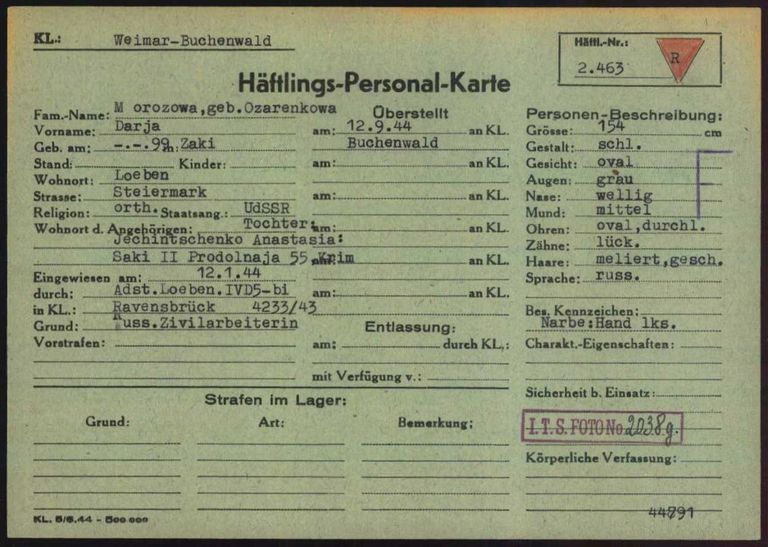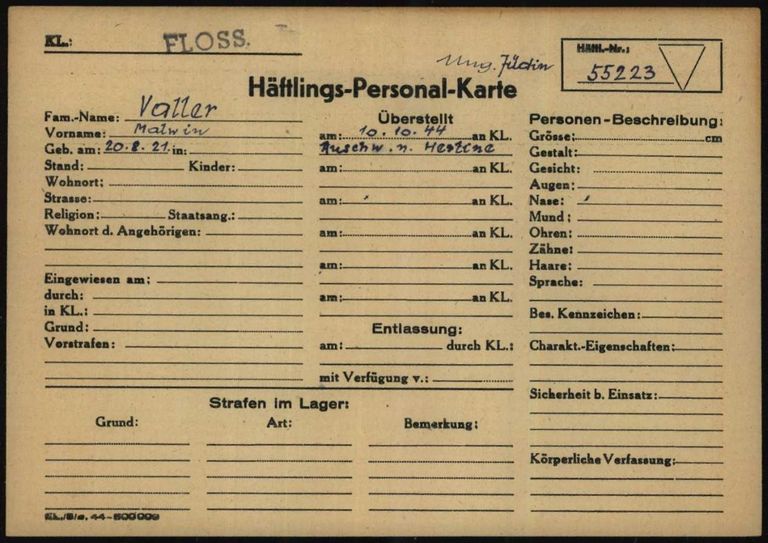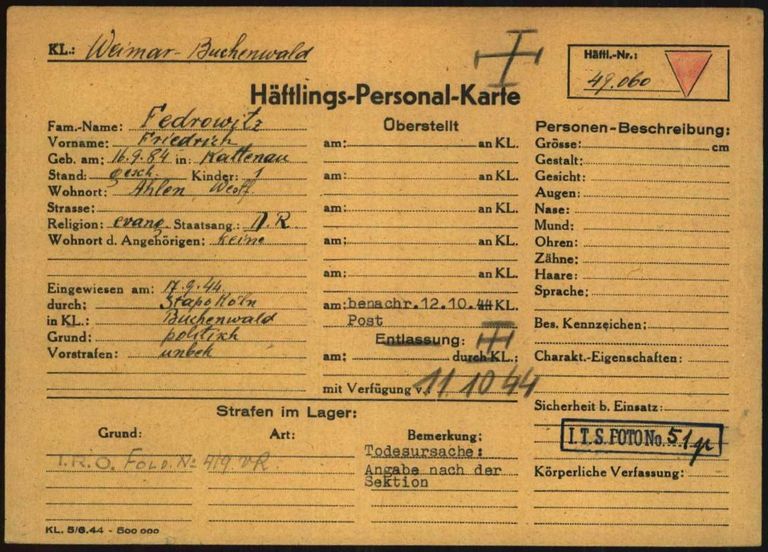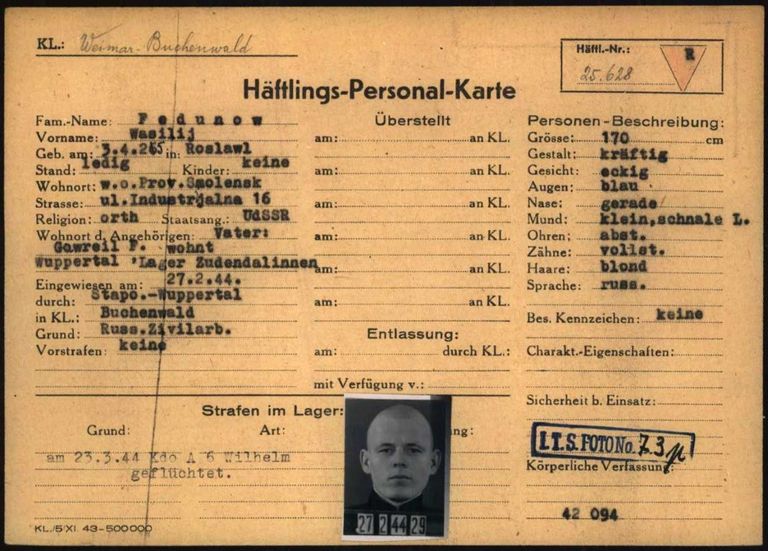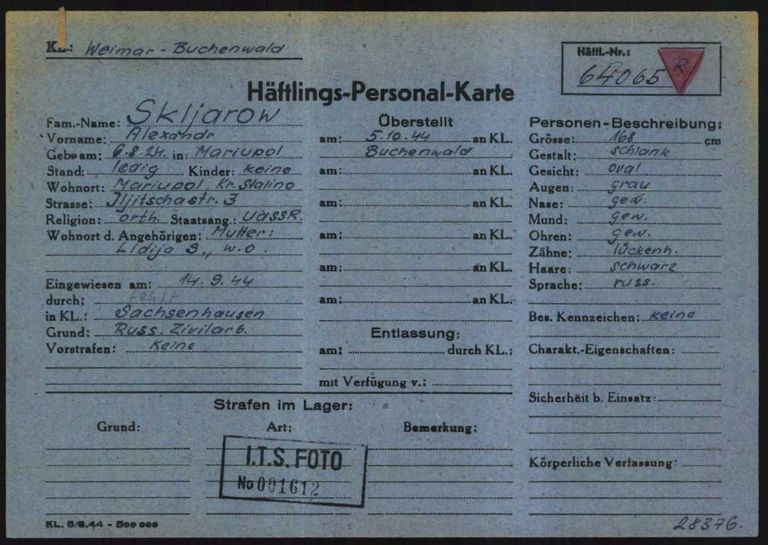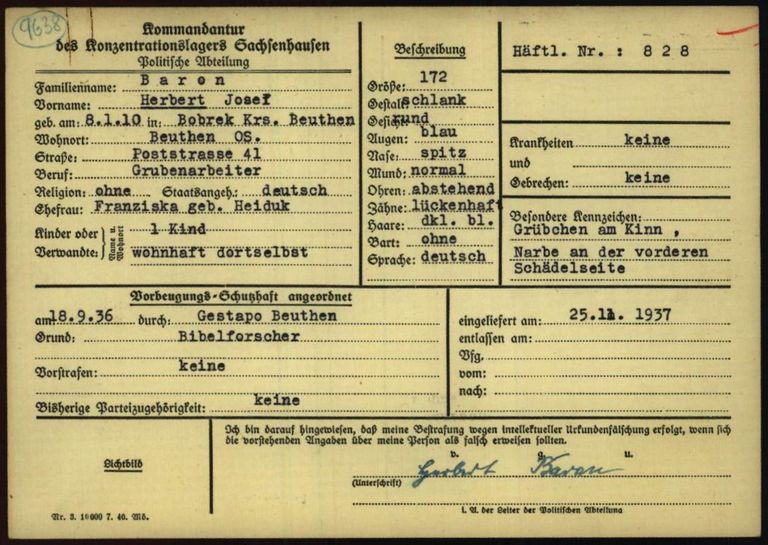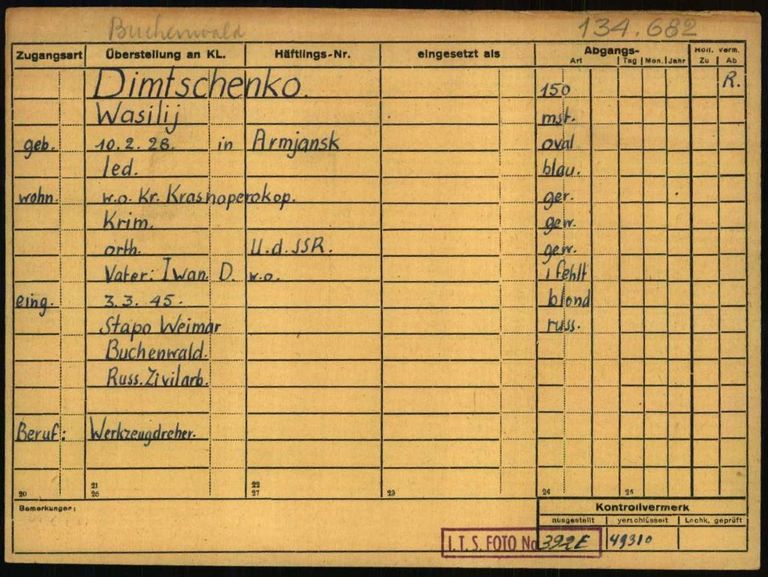Page of
Page/
- Reference
- Intro
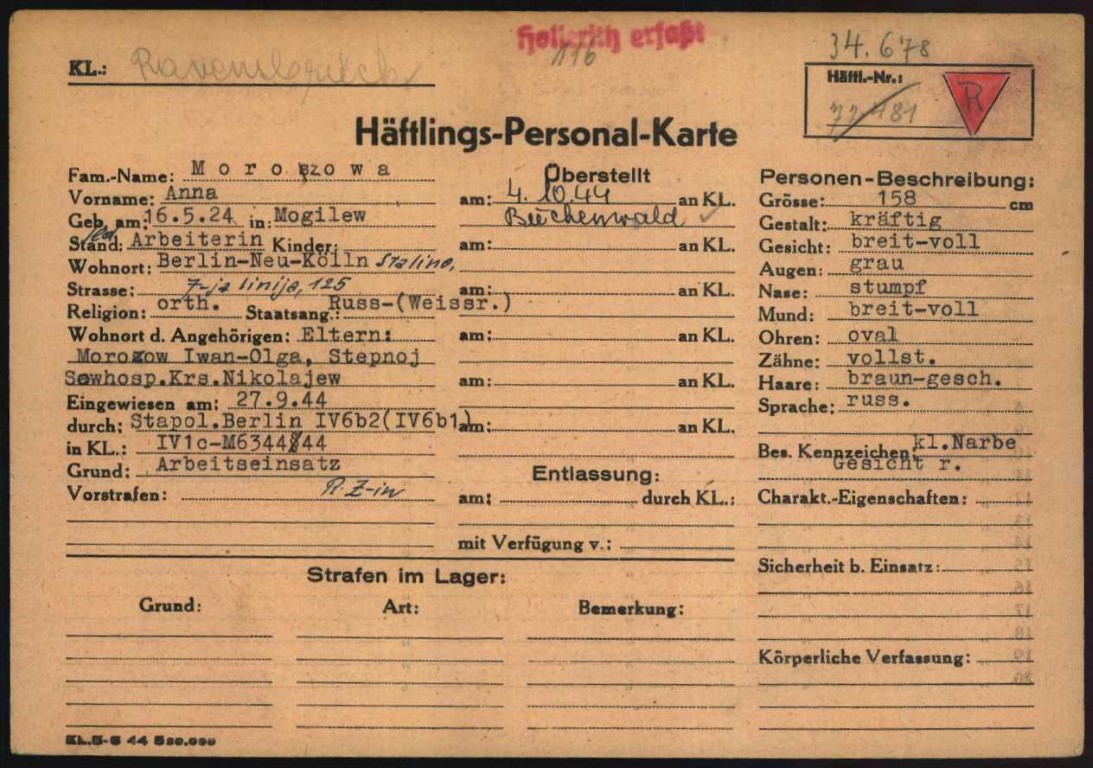

This is a Prisoner Registration Card. These cards were created for concentration camp prisoners in all of the main camps. At first glance, the cards look very diverse; they come in various colors, they were filled out by prisoner clerks either by hand or on a typewriter, and sometimes a photo of the prisoner was pasted to the card. Some of the cards have been filled out completely, but some are missing the personal description in the right-hand column. Nonetheless, all of these cards are the same document, and they were used for all age groups, nationalities and prisoner categories.
This is a Prisoner Registration Card. These cards were created for concentration camp prisoners in all of the main camps. At first glance, the cards look very diverse; they come in various colors, they were filled out by prisoner clerks either by hand or on a typewriter, and sometimes a photo of the prisoner was pasted to the card. Some of the cards have been filled out completely, but some are missing the personal description in the right-hand column. Nonetheless, all of these cards are the same document, and they were used for all age groups, nationalities and prisoner categories.
Questions and answers
-
Where was the document used and who created it?
Whenever a new prisoner arrived at a concentration camp, a Prisoner Registration Card was created, listing all important personal details. These cards were based on information from the files available to the Political Department, which could include “preventive detention” orders, the prisoner’s Lebenslauf (“curriculum vitae”) and their prisoner registration form. The Political Department (the Gestapo in the camps) often used interrogations as an opportunity to harass and abuse newly arrived prisoners. As the number of new arrivals continued to grow, prisoner functionaries in the arrivals office of the Political Department were increasingly tasked with registering new prisoners. After the Prisoner Registration Cards had been filled out, they were stored in the registry of the Political Department, and they were updated when a prisoner was transferred to a different camp or died. Prisoner Registration Cards and registration forms were so important that very few prisoner functionaries had access to them. At Auschwitz, the rooms in which the cards were stored were extra secured, for example.
- When was the document used?
Even in the early concentration camps, predecessors to the Prisoner Registration Cards were created for “protective custody” prisoners from 1933 onwards. Their design changed over the years, but they were used in all concentration camps until 1945. From around 1942/1943 it was mandatory to use standardized Prisoner Registration Cards. Their color ranged from yellow to green to blue, largely on account of the growing shortage of paper. These new, standardized Prisoner Registration Cards were printed as blank forms in the Auschwitz camp printing office and were distributed to the various concentration camps. A document identification number was printed at the lower left edge of these cards: the abbreviation KL/ is followed by a number as well as the month and year of production. The blank forms were regularly updated and assigned a new order number. Up to 500,000 copies would be printed in one run.
- What was the document used for?
The Political Department of a camp was responsible for recording the identifying details of all prisoners. If prisoners escaped from the camp, for example, the SS would use the information on their Prisoner Registration Card to find them. These cards listed all of the information relevant to recapturing the person. This explains why there is a column for the prisoner’s physical description, which was used as a kind of “wanted” profile. For the same reason, some Prisoner Registration Cards also include portrait photos of the prisoner.
Unlike the detailed two-page prisoner registration forms, Prisoner Registration Cards were used to record only crucial information about a prisoner. Since reassignments and transfers to other camps were also noted on these cards, it was possible to determine where a prisoner was at any given time.
On the back of the Prisoner Registration Cards, there were blank spaces for providing information relevant to a prisoner’s labor assignments. This included the prisoner’s education, the occupation for which they had been trained and their work experience. Labor assignments and their duration were also supposed to be noted here. But because there was a separate department in the camps for planning labor assignments, these fields are blank on nearly all Prisoner Registration Cards.
- How common is the document?
Prisoner Registration Cards were issued for all prisoners who arrived at a concentration camp. However, the number of cards that the Arolsen Archives hold from different camps varies widely. A list from the year 1951 mentions – as a rough framework – 200,000 Prisoner Registration Cards from Buchenwald and over 8,500 microfilmed cards from Mauthausen. There are hardly any Prisoner Registration Cards from Dachau, by contrast, because they were probably destroyed shortly before the end of the war. Although not all cards have been preserved, the Arolsen Archives have a good number of cards especially from the last years of the war from camps such as Buchenwald. No cards were created for people who were murdered by the SS immediately after arriving at an extermination camp, however. Therefore, deportation lists are usually the only source of information about whether a person was sent to an extermination camp.
- What should be considered when working with the document?
Many of the Prisoner Registration Cards in the Arolsen Archives were not filled out completely. Both the back of the cards and the spaces for the prisoner’s physical description are often blank. If comments were made about a prisoner’s appearance, they could be derogatory. For example, on the Prisoner Registration Cards for Andor Szabadi and Istvan Szabados, two Jewish men from Hungary, both are described as having a “hooked nose.” Additionally, the Charakterliche Eigenschaften (“character traits”) field was sometimes used by the Political Department to point out supposed characteristics such as “laziness.” These fields can therefore include stereotypical Nazi assumptions about other nationalities or prisoner groups.
If a prisoner was transferred to another camp, there may be multiple Prisoner Registration Cards for him or her in the collections of the Arolsen Archives. The Prisoner Registration Cards for female prisoners in the sub-camps of Ravensbrück are a special case. In September 1944, some of the Ravensbrück sub-camps were placed under the administration of Buchenwald. Therefore, although the women themselves remained in the same camp, they have two Prisoner Registration Cards: one from Ravensbrück and one from Buchenwald.
The term “prisoner registration card” – like number card – was often used by the ITS to refer to different types of file cards. For example, the following cards are also generally referred to as prisoner registration cards: the cards for report leaders with a special space for punishments on the back, the arrivals file cards of the registry office, and a card from the collection of Sachsenhausen concentration camp, the purpose of which is unclear. Very few of the cards referred to as prisoner registration cards at the ITS over the past 70 years were actually part of the card files of the Political Departments in the concentration camps.
If you have any additional information about this document or any other documents described in the e-Guide, we would appreciate it very much if you could send your feedback to eguide@arolsen-archives.org. The document descriptions are updated regularly – and the best way for us to do this is by incorporating the knowledge you share with us.
Help for documents
About the scan of this document <br> Markings on scan <br> Questions and answers about the document <br> More sample cards <br> Variants of the document
